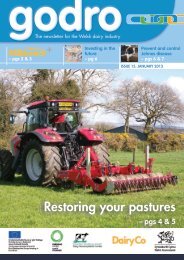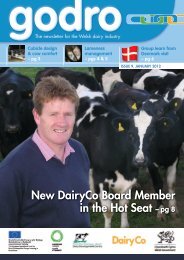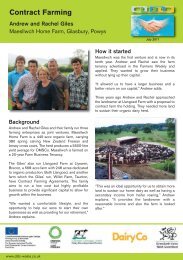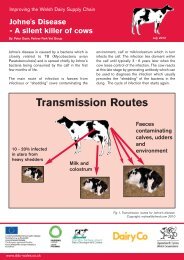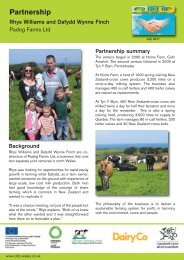Cow Hire Agreement - Dairy Development Centre
Cow Hire Agreement - Dairy Development Centre
Cow Hire Agreement - Dairy Development Centre
Create successful ePaper yourself
Turn your PDF publications into a flip-book with our unique Google optimized e-Paper software.
Improving the Welsh <strong>Dairy</strong> Supply Chain<br />
<strong>Cow</strong> <strong>Hire</strong> <strong>Agreement</strong><br />
www.ddc-wales.co.uk
<strong>Dairy</strong> <strong>Development</strong> <strong>Centre</strong><br />
Gelli Aur<br />
Carmarthen<br />
Carmarthenshire<br />
SA32 8NJ<br />
Telephone: 01554 748570<br />
E-mail: ddc@colegsirgar.ac.uk<br />
www.ddc-wales.co.uk<br />
July 2012<br />
The <strong>Dairy</strong> <strong>Development</strong> <strong>Centre</strong> (DDC) acknowledges the contribution made by<br />
The Andersons <strong>Centre</strong> to the technical content of this booklet.<br />
This project has received funding through the Rural <strong>Development</strong> Plan for Wales 2007-2013 which<br />
is funded by the Welsh Government and the European Agricultural Fund for Rural <strong>Development</strong>.<br />
No part of this publication may be reproduced or transmitted in any form by any means without the prior<br />
written consent of the <strong>Dairy</strong> <strong>Development</strong> <strong>Centre</strong>.<br />
Whilst all reasonable care has been taken in its preparation, no warranty is given as to its accuracy, no liability<br />
accepted for any loss or damage caused by reliance upon any statement in or omission from this publication.
Contents<br />
Introduction to Collaborative Farm Ventures 4<br />
Collaborative Farm Ventures Decision Tree 5<br />
<strong>Cow</strong> <strong>Hire</strong> 6<br />
Background 6<br />
What is it? 7<br />
Objectives 8<br />
Suitability in the Welsh <strong>Dairy</strong> Industry 8<br />
<strong>Cow</strong> owner perspective 8<br />
Strengths 9<br />
Weaknesses 9<br />
<strong>Cow</strong> hirer perspective 9<br />
Strengths 9<br />
Weaknesses 9<br />
Other Points to Consider 10<br />
Animal health 10<br />
Insurance 10<br />
Taxation 11<br />
Legal 11<br />
The contract 12<br />
Providing an Economic Return; Calculating the Fee 13<br />
<strong>Cow</strong> <strong>Hire</strong> Calculation Example 14<br />
Case Studies – <strong>Cow</strong> <strong>Hire</strong> 15<br />
Case Study 1 15<br />
Case Study 2 16<br />
Heads of terms 17<br />
<strong>Cow</strong> <strong>Hire</strong> <strong>Agreement</strong> 3
Introduction to Collaborative Ventures<br />
Put simply, farmer collaboration consists of two or more farm businesses or persons<br />
getting together, sharing resources to reduce cost and or increase profitability. They<br />
are relatively common throughout other sectors of UK agriculture, however they are<br />
relatively new to dairying.<br />
There are a number of reasons for collaboration, these include:<br />
• Improving profitability<br />
• Economies of scale and synergies – cost control<br />
• Personal benefits – quality of life<br />
• Allows succession<br />
• Efficient use of capital<br />
It is essential that a budget is always considered before any agreement commences<br />
to ensure viability and delivery of all parties’ expectations. It is important that each<br />
individual partner that is considering a collaborative venture seeks professional<br />
advice. There is a shortage of such persons who have adequate knowledge of the<br />
subject. Consequently, a farming business could suffer unnecessary delay and cost<br />
in the establishment of their agreement, hence the use of checklists and templates<br />
provided via the <strong>Dairy</strong> <strong>Development</strong> <strong>Centre</strong> (DDC).<br />
The following information can be used by farming businesses and/or their professional<br />
advisors to assist in highlighting potential solutions and provide guidance regarding the<br />
points to consider in preparation of a venture being entered into.<br />
This is one booklet in a series and is specific to one type of collaborative venture.<br />
To view the Collaborative Ventures report or the other information booklets go to the<br />
website www.ddc-wales.co.uk or contact the DDC.<br />
For a copy of <strong>Dairy</strong>Co’s Joint Venture templates that provide guidance to dairy<br />
farmers who are considering a joint venture with other dairy businesses, or bringing<br />
others into the business structure, contact <strong>Dairy</strong>Co publications on 02476 478702.<br />
4 <strong>Cow</strong> <strong>Hire</strong> <strong>Agreement</strong>
Collaborative Farm Ventures Decision Tree<br />
START<br />
Do I need others to grow my<br />
business?<br />
Yes<br />
No<br />
Grow by purchasing or renting<br />
additional land and facilities<br />
Do I need to be in total control of<br />
all aspects of my business?<br />
Yes<br />
No<br />
Do I want to<br />
access more<br />
resources than I<br />
can justify?<br />
Seek<br />
Forage Growing <strong>Agreement</strong>/<br />
Contract Rearing <strong>Agreement</strong><br />
Consider a Partnership<br />
or Company<br />
Yes<br />
Yes<br />
Do I want limited liability?<br />
Yes<br />
No<br />
Is it machinery or labour?<br />
Ltd<br />
Company<br />
Limited<br />
Liability<br />
Partnership<br />
Partnership<br />
Machinery<br />
Labour<br />
Join<br />
Machinery<br />
Ring<br />
Arrange to join<br />
a labour sharing<br />
“club”<br />
<strong>Cow</strong> <strong>Hire</strong> <strong>Agreement</strong> 5
Background<br />
Increasing herd sizes in order to achieve economies of scale and production<br />
efficiencies has been a constant trend on dairy farms throughout the UK and indeed<br />
internationally for many years. However, having sufficient capital/cash available to<br />
purchase cows and invest in infrastructure (at the same time)<br />
when looking to expand can be a challenge, and is often a<br />
limiting factor especially for tenants without a strong<br />
balance sheet. It may also be that there are<br />
sufficient numbers youngstock to come through<br />
but they may not be ready to produce for a<br />
further two years after the infrastructure<br />
capital investment. Either way there may be<br />
a demand for cows (short or medium<br />
term).<br />
Alternatively, whilst many dairy farmers<br />
are looking to expand, others may be<br />
looking to give up ‘active’ milk<br />
production but may wish to keep their<br />
dairy herd in order to provide an income<br />
stream (via a realistic return on capital of<br />
at least 10%), maintain tax advantages<br />
and ensure flexibility in the future.<br />
Surplus cows can also be available from<br />
farms that have sustainable low replacement<br />
rates and their owner(s) may wish to retain them<br />
as assets to receive a Return On Capital (ROC)<br />
rather than sell them and invest elsewhere.<br />
Farmers are familiar with the practice of renting/hiring/leasing<br />
in order to gain control of resources such as land, buildings and<br />
machinery, thus cow hire may also be a mutually beneficial solution.<br />
The cow hire agreements can be a method by which a herdsman or new entrant can<br />
grow their balance sheet before they commence farming in their own right, without<br />
the need for a large amount of capital. <strong>Cow</strong> hire can enable the dairy farming<br />
business to start and then over time the farmer (hirer) can build equity by purchasing<br />
cows in the medium and long-term to replace those that have been hired.<br />
6 <strong>Cow</strong> <strong>Hire</strong> <strong>Agreement</strong>
What is it?<br />
<strong>Cow</strong> hire agreements allows a dairy farmer who wishes to obtain additional cows<br />
to 'hire' them.<br />
For the purpose of this booklet from now on the person wishing to hire extra<br />
cows will be referred to as the ‘hirer’ and the owner of cows who wishes to hire<br />
them out to somebody else will be referred to as the ‘owner’.<br />
The owner retains ownership of the cows, receives an annual hire fee and also<br />
receives the cull and calf income, but pays the cost of semen for breeding. The<br />
owner is also responsible for providing a replacement should a ‘hired’ cow need<br />
to be culled or dies.<br />
The hirer is able to increase herd size rapidly without a big initial outlay, or the<br />
need to breed/rear additional youngstock. The hirer covers all the costs of<br />
keeping the cow (minus those outlined above) plus the annual hire fee, but<br />
retains all the milk income.<br />
<strong>Cow</strong> <strong>Hire</strong> <strong>Agreement</strong> 7
Objectives<br />
• Provides the cow owner with a reliable/sustainable income, beneficial tax status,<br />
future flexibility, personal interest/satisfaction and maintaining ownership of the<br />
herd as opposed to herd dispersal. Enables the hirer to obtain additional cows<br />
without further investment in stock and allows a degree of risk management for<br />
budgeting and business planning/growth.<br />
• If the agreement is to succeed it is essential to match the ‘right cow’ (owner) with<br />
the ‘right operator’ (hirer) as the two effectively become ‘partners’ in business and<br />
thus need to be chosen wisely.<br />
8 <strong>Cow</strong> <strong>Hire</strong> <strong>Agreement</strong>
Suitability in the Welsh <strong>Dairy</strong> Industry<br />
<strong>Cow</strong> owner perspective<br />
<strong>Cow</strong> hirer perspective<br />
Strengths<br />
• Retain the ownership of a dairy herd without the<br />
requirement to provide labour and resources to<br />
operate a dairy farm.<br />
• Allows resources to be exploited for alternative<br />
means/enterprises i.e. 60 dairy cow cubicles could<br />
be adjusted to house 90 Heifers.<br />
• Releases fixed capital not needed for a milking unit<br />
i.e. feeder wagon, bulk tank.<br />
• Provides a reliable return on capital which has been<br />
invested in the cows.<br />
• May provide a temporary solution for specific<br />
situations/transition e.g. owner growing their herd<br />
size in order to obtain additional land/move farm in<br />
future. Succession planning/career break etc.<br />
• Facilitates partnership agreements; sharing the<br />
practicalities of milking, contract arrangements and<br />
incorporating a successor into the business.<br />
• May provide an opportunity to exploit appreciation<br />
in dairy cow values in the future rather than<br />
dispersing the herd at the current time.<br />
• Avoid increased tax liabilities that could arise in the<br />
case of herd dispersal, whilst maintaining farm<br />
income for inheritance/income tax purposes.<br />
• Maintain personal satisfaction and interest in owning/<br />
breeding of dairy cows, whilst providing the<br />
opportunity to utilise progeny for alternative purposes.<br />
Weaknesses<br />
• Responsibility for care/health/welfare of cows is<br />
entrusted to others.<br />
• Reliance on good business performance capability<br />
of the hirer.<br />
• Risk of financial loss if dairy cow values fall both in<br />
opportunity cost of dispersal and reduced return on<br />
capital (hire fee).<br />
• Inability to immediately access the capital (within<br />
the term of the agreement) tied up in the cows<br />
should circumstances change.<br />
• <strong>Cow</strong>s may be some distance away from owner which<br />
make monitoring cow health and condition difficult.<br />
Strengths<br />
• Can allocate potentially limited capital<br />
that would be used to purchase dairy<br />
cows to alternative uses (land/milking<br />
facilities etc.).<br />
• Gain access to dairy cows which may<br />
otherwise be unaffordable, with the<br />
opportunity to select suitable genetics/<br />
cow type, which would otherwise take<br />
time to breed.<br />
• Facilitates easier access for new<br />
entrants to the industry due to reduced<br />
capital demands.<br />
• Manage timing of cow hire fees to suit<br />
cash flow.<br />
• Avoid the need to use credit/borrowing<br />
to finance the purchase of dairy cows.<br />
• Mitigate some financial loss that may<br />
occur if the market price of dairy cows<br />
falls.<br />
• An element of ‘production risk sharing’.<br />
• <strong>Cow</strong> hire fees accounted as ‘operating<br />
expenditure’ rather than depreciating<br />
cost of purchased cows.<br />
Weaknesses<br />
• Uncertainty beyond the term of the hire<br />
agreement as to the availability of cows.<br />
• Unpredictability with regard to the cost<br />
of leasing dairy cows in the future<br />
(although this can be agreed) -<br />
normally reviewed every three years.<br />
• Limitations on how the cows may be<br />
managed/ appropriateness for the<br />
system (e.g. calving date).<br />
• Short term biosecurity risk by ‘bringing<br />
in’ cows, particularly if cows are from<br />
multiple sources.<br />
• Opportunity cost of appreciation, if<br />
dairy cow values rise compared with<br />
outright purchasing.<br />
<strong>Cow</strong> <strong>Hire</strong> <strong>Agreement</strong> 9
Other Points<br />
Animal health<br />
Where any movement of different stock between holdings take place whether it is<br />
through purchase, hire or other means there is an inherent biosecurity and animal<br />
health risk. Good communication at an early stage is vital to minimise the risks. The<br />
veterinary surgeons of both parties' (owner and hirer) should be involved in drawing<br />
up a plan which identifies differences in each parties’ disease status and documents<br />
how each health issue will be managed (vaccination protocol, disease monitoring<br />
etc.).<br />
Clearly, in situations where the hirer is bringing in stock from multiple sources<br />
(whether it be through hire or purchase) the disease risk is increased and needs to<br />
be very carefully managed. Correspondingly, where the hirer maintains effectively a<br />
‘closed’ herd and only hires from one source the potential risk can be lowered.<br />
Where cows are culled under bovine tuberculosis (bTB) control measures, the<br />
compensation is paid to the owner of the cows. The owner then replaces that animal<br />
as he/she would under the cow hire fee for any normal herd replacement.<br />
Insurance<br />
It is normally the responsibility of the cow hirer to insure the cows whilst they are on<br />
hire to an agreed (with the owner) value. Such cover should include the following<br />
perils:<br />
• Malicious attack<br />
• Fire<br />
• Aircraft<br />
• Electrocution<br />
• Drowning<br />
• Damage from falling objects<br />
• Straying<br />
Seeking advice from your insurance advisor is recommended.<br />
10 <strong>Cow</strong> <strong>Hire</strong> <strong>Agreement</strong>
Taxation & Legal<br />
Taxation<br />
The cow owner will receive three parts of income from the cow hire fee as follows:<br />
(For further explanation of the income received by the cow owner<br />
please see <strong>Cow</strong> <strong>Hire</strong> Calculation Example on page 14)<br />
1. The proceeds of all calf and cull cow sales less all<br />
breeding costs (e.g. natural service bull, AI and<br />
insemination fees).<br />
2. The difference between the “new heifer”<br />
price (i.e. between £1000 and £1200) and<br />
the above net figure divided by the annual<br />
replacement rate.<br />
3. The agreed rate of return (i.e. ROC) for the<br />
capital value.<br />
Income for all the above forms part of the normal<br />
trading receipts and all expenses of rearing can<br />
be offset against this before profits are calculated.<br />
The cow hirer can offset the hire charge against the<br />
normal dairy farm trading income before taxes are<br />
calculated.<br />
It is understood that currently no VAT should be charged on the cow hire fee but this<br />
should be reviewed when a <strong>Cow</strong> <strong>Hire</strong> <strong>Agreement</strong> is established.<br />
Legal<br />
The establishment of the cow hire agreement will be legally binding when both the<br />
owner and the hirer have signed the documentation under the Law of Contract. It is<br />
essential that such an agreement is documented and signed to protect both parties.<br />
A good cow hire agreement ensures an economic return for both parties. There may<br />
be occasional problems whether it is due to fertility, cow performance, stock<br />
husbandry, either on the part of the cow hirer or the owner, which may result in<br />
reference to the official document to provide clarity to the issue whilst minimising the<br />
risk of conflict or confusion.<br />
<strong>Cow</strong> <strong>Hire</strong> <strong>Agreement</strong> 11
The Contract<br />
The main terms that should be covered within the contract include the following:<br />
• Length of hire agreement: This will depend on specific circumstances but is<br />
typically 3 – 5 years and is normally determined by the hirer replacing cows owned<br />
by him, if the dairy business size remains static. <strong>Cow</strong> hire could continue if the<br />
business grows.<br />
• Payment rate: This should include a full breakdown of the cow hire fee<br />
calculation.<br />
• Timing of payments: This is usually monthly, calculated by the number of days<br />
each cow is on the farm or alternatively a forecast is made annually of monthly cow<br />
numbers with a full reconciliation at the end of the business year.<br />
• Rights and obligation of the owner: This would consist of permission to check<br />
the cows, which could be once a month or quarterly, but so as to not cause<br />
inconvenience to the hirer.<br />
• Rights and obligations of hirer: Feeding, management etc.<br />
• Health protocol: Any vaccines and/or veterinary/medical treatments to be<br />
detailed and agreed beforehand if applicable.<br />
• Animal identification and record keeping: The hirer is responsible for<br />
ensuring that the hired cows have the appropriate identification tags and the hirer<br />
should pay for any replacement tags required. In terms of cross-compliance, it is<br />
the responsibility of the ‘keeper’ (defined as the person with responsibility for dayto-day<br />
management of the animals) to ensure all animal identification (ear tags)<br />
are in place - this is the hirer.<br />
• Insurance: It is usually the responsibility of the hirer to insure the cows. With this<br />
in place the losses/deaths would be determined as covered insurance.<br />
• Terms of buy-out options, if any: It is possible, if agreeable between the cow<br />
owner and the cow hirer, to structure a method by which the hirer could purchase<br />
the cows over a period of time.<br />
• Procedure for settling disputes / arbitration<br />
• Conditions for termination of an agreement<br />
12 <strong>Cow</strong> <strong>Hire</strong> <strong>Agreement</strong>
Providing an Economic Return - Calculating the <strong>Cow</strong> <strong>Hire</strong> Fee<br />
Both the owner and hirer must appreciate<br />
there may be conflicting financial goals<br />
when negotiating a cow hire fee. The hirer<br />
may desire to pay as little as possible in<br />
order to maximise the potential for profit,<br />
whilst conversely the owner wants to gain<br />
as high a fee as possible to maximise<br />
the return.<br />
For this reason it is important that<br />
both parties understand the<br />
purpose of a ‘fair’ cow hire fee;<br />
it is an economic return that<br />
compensates an owner for<br />
investing capital in dairy<br />
cows. As well as providing a<br />
return on capital, the fee<br />
should take into account<br />
replacement rate, cull and<br />
calf value and breeding<br />
costs. The following table<br />
shows an example of a cow<br />
hire fee calculation based on a<br />
replacement rate of 25% and a<br />
return on capital (ROC) of 10%.<br />
A ROC rate of 10% is chosen as<br />
this represents the opportunity cost<br />
of that investment, for example the<br />
owner of the cows could choose to invest<br />
his/her capital elsewhere in other business<br />
opportunities if not investing in dairy cows.<br />
<strong>Cow</strong> <strong>Hire</strong> <strong>Agreement</strong> 13
<strong>Cow</strong> <strong>Hire</strong> Calculation Example<br />
Replacement rate 25%<br />
<strong>Cow</strong> Price £ 1,000.00<br />
Cull <strong>Cow</strong> £ 350<br />
Loss £ 650 x 0.25 = £162.50<br />
Calf Income<br />
Heifer £ 200 x 0.45 = £90.00<br />
Bull £ £ x 0.55 = £5.50<br />
Beef x £ £<br />
£95.50<br />
Semen Cost £30.00 - Calf income = £65.50<br />
Replacement £162.50<br />
Calf income - £65.50<br />
Plus ROC 0.1 £100.00<br />
Payable £ £197<br />
The replacement rate of the farm that<br />
cows will be hired to.<br />
This is the average value received for<br />
a cull cow, including an allowance for<br />
mortality. With the replacement rate<br />
as above, this shows the depreciation<br />
cost of the cow per year.<br />
This represents the split between<br />
heifer and bull calves. UK statistics<br />
demonstrate this 55%:45% split in<br />
favour of bull calves. If cows were to<br />
be served to beef bred bulls, then the<br />
split would have to account for beef<br />
calves also.<br />
This is the weighted average value of<br />
the calves per cow hired. Calves<br />
belong to the cow owner.<br />
The cow owner pays for the semen<br />
but retains all calves. Semen cost is<br />
therefore deducted from the calf<br />
income to arrive at the net income to<br />
the owner.<br />
Return On Capital (ROC) represents<br />
the return paid to the owner for the<br />
capital tied up in cows. <strong>Cow</strong>s valued<br />
at £1,000 @ 10%.<br />
This is the fee payable per cow for<br />
that year, which includes the<br />
replacement cost.<br />
The example above would require an annual fee of £197 per cow paid by the hirer to<br />
the owner. Through examining the fundamentals of calculating a cow hire fee it is<br />
clear to see how the conflicting financial goals of the two parties above can be<br />
balanced and the importance of joining the right hirer with the right owner. For<br />
example in the case outlined above; if the hirer is able to achieve a lower<br />
replacement rate of 18% and semen cost of £22 through a combination of<br />
management/stockmanship ability and utilising the right type of cow, the annual cow<br />
hire fee could be reduced to £143.50. The owner is still achieving the same level of<br />
‘return’ because his costs (of owning the cow) are lower, whilst the hirer also keeps<br />
costs lower (the hire fee) and therefore has a greater potential for profit. The ROC %<br />
paid to the owner may potentially be increased to reflect this.<br />
14 <strong>Cow</strong> <strong>Hire</strong> <strong>Agreement</strong>
Case Study 1<br />
First time Tenant Farmer (new tenancy opportunity) is a herdsman and has limited<br />
capital available and limited borrowing capacity due to security.<br />
The farm being rented is 210 acres and funding is required for 130 cows. In goings<br />
include the existing bulk tank and parlour along with other ‘deadstock’ (i.e. silage and<br />
growing crops). The total capital demand for the ingoing tenant is therefore is<br />
approximately £170,000 but available capital (cash and borrowings) is only<br />
£110,000. Therefore, there is a deficit of £60,000 – which equates to 60 cows.<br />
Option 1 for the tenant:<br />
Farm with only 70 cows in milk and try to increase cow numbers from within over the<br />
next 4 – 5 years. Low profitability and free cash will inevitable be an issue due to<br />
high rent and other fixed costs of operating an under-stocked 210 acre farm. Other<br />
options may include using the excess acreage for beef/sheep/arable– but this will<br />
complicate the system and the farmer would not be utilising the existing parlour and<br />
bulk tank facility to their full extent.<br />
Option 2 for the tenant:<br />
Farmer will own 70 cows and hire in 60 cows (effectively using someone else’s<br />
capital).<br />
It is then possible to hire the cows for the term of the tenancy and rear his own<br />
heifers to come into the herd over the next 4 – 5 years. This would result in the cow<br />
owner having to find an alternative cow hirer at the end of the contract.<br />
<strong>Cow</strong> <strong>Hire</strong> <strong>Agreement</strong> 15
Case Study 2<br />
55 – 65 year old dairy farmer (Farmer A) is seeking to retire from milking due to<br />
age/declining health/mobility and age of milking facilities. Located nearby is a<br />
“trusted and respected” active dairy farmer (Farmer B) wishing to keep more cows<br />
and have his heifers contract reared.<br />
Solution:<br />
Farmer A hires his cows to Farmer B whilst in return he contract rears heifers for<br />
Farmer B as well as his own heifers as replacements for Farmer B.<br />
16 <strong>Cow</strong> <strong>Hire</strong> <strong>Agreement</strong>
Heads of Terms<br />
Please find below the minimum requirements that should be included in an agreement.<br />
<strong>Cow</strong> <strong>Hire</strong> AGREEMENT<br />
1. Farmer (<strong>Cow</strong> Owner) Details<br />
1.1 Name of Farmer<br />
1.2 Trading Title of Farmers Business<br />
Please tick<br />
Trading Business Status<br />
Sole Trader<br />
Partnership<br />
Limited Liability Partnership<br />
Company<br />
1.3 Trading Business Address<br />
2. Farmer (<strong>Cow</strong> <strong>Hire</strong>r) Details<br />
2.1 Name of Farmer<br />
2.2 Trading Title of Farming Business<br />
2.3 Trading Business Status<br />
2.4 Trading Business Address<br />
<strong>Cow</strong> <strong>Hire</strong> <strong>Agreement</strong> 17
3. Farm Details<br />
3.1 Address of farm on which the hired cows will be kept (if different to <strong>Cow</strong><br />
<strong>Hire</strong>r’s trading address)<br />
3.2 Farmable Area of Land<br />
4. <strong>Agreement</strong> Length<br />
4.1 Date of Commencement of <strong>Agreement</strong><br />
4.2 Year End of <strong>Agreement</strong><br />
4.3 Length of <strong>Agreement</strong> and/or termination date<br />
5. Specific <strong>Cow</strong> <strong>Hire</strong> <strong>Agreement</strong> Details<br />
5.1 Number of <strong>Cow</strong>s to be hired<br />
5.2 Agreed <strong>Hire</strong> Fee per cow (First three years)<br />
5.3 Fee Payment Frequency<br />
18 <strong>Cow</strong> <strong>Hire</strong> <strong>Agreement</strong>




